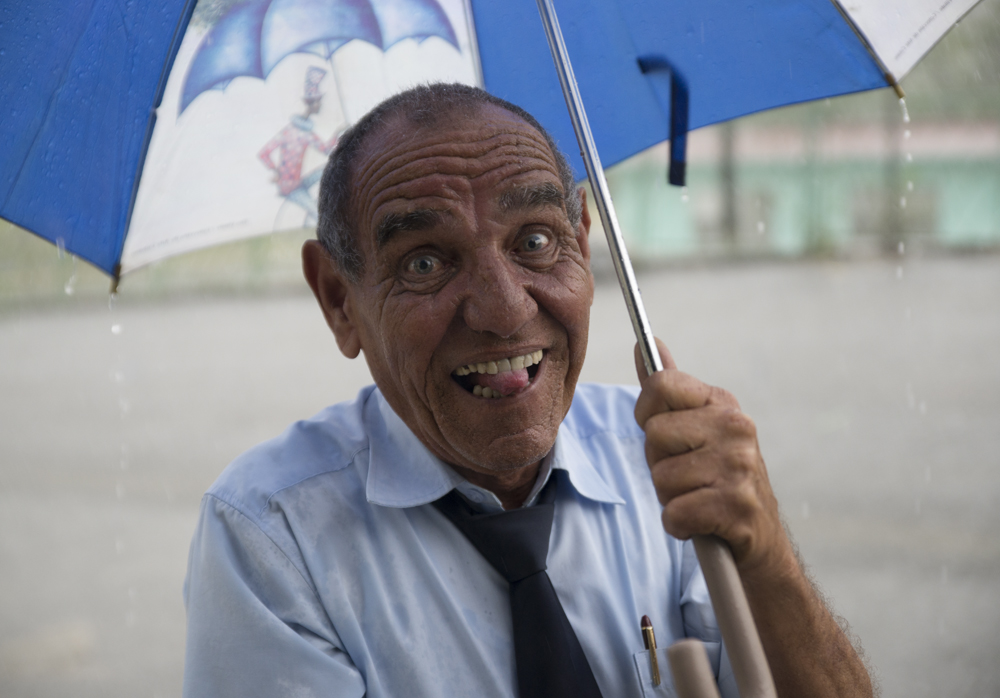I love to travel. Sure, I like trying new foods and immersing myself in cities already centuries old when my native Seattle was just unexplored frontier. But the main reason I keep reaching for my passport is to find experiences that stand in stark contrast with my normal day-to-day life back home, like puppets having sex on prime time TV or “edible” beetle larvae.
Sometimes you have to really look for these experiences (overly positive news anchors in Canada); other times they smack you in the face just as you step off the plane (India). Even though it lies only 90 miles from the US shoreline, I suspected that Cuba, as a country in many ways stuck in the middle of the 20th century, was replete with opportunities for me to be baffled, stunned and amazed.
I couldn’t wait.
During our six day tour of the country – primarily in Havana, with a couple days in Viñales – we encountered a nice list of “shit that just wouldn’t fly back home.” None of these observations are right nor wrong, just different. My tone, at times, can be a bit snarky, but most of it is directed at my own culture, and not that of my hosts.
“Slick’r than Snot” Tile Floors
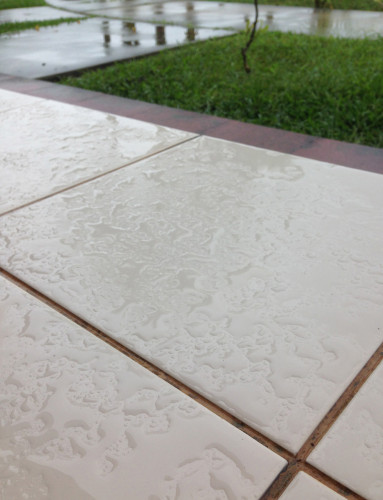
Cuba is a tropical island, therefore it rains. About four feet annually, in fact. So it’s reasonable to assume that people will enter homes or establishments with less-than-dry shoes, where they will almost certainly encounter tile floors. I have nothing against tile: they are great for repelling water and mud—easy to clean, to boot. When wet, however, tile floors provide as much traction as a lunch tray on an icy hillside. This would never “slide” in the U.S., where our cultural clumsiness is matched only by our propensity to sue the crap out of each other. If there’s a spill in Aisle 5 of a grocery store, managers will quarantine aisles 1 through 10 using CDC Level 5 protocols.
Our Cuban-owned hotel in Viñales apparently even waxed the tiles on our outdoor patios, perhaps so when traction is lost, the enhanced momentum would carry the victim past the single step – and its sharp, neck-breaking edge – to land on the soft grass beyond. In the event of a fall, I maintained an optimized “blood-to-rum” ratio to soften the impact.
No “Yellow Line”
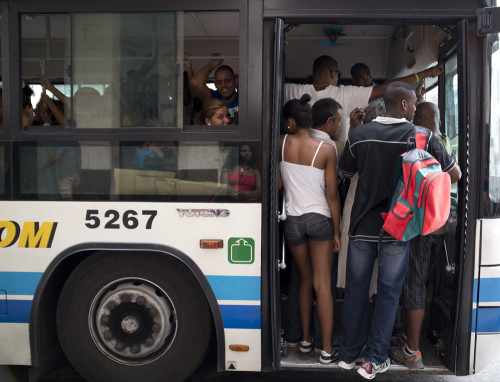
If you taken the bus in the US, you’ve been yelled at for not standing behind the yellow line. It’s a fact of life. In Cuba, that space could easily fit a dozen people. In downtown Havana, I watched with amazement as a man – in order to fit behind a closing door – contorted himself and his backpack into positions not yet discovered by Bikram Choudhury. The door attempted to close, then was obstructed by the mans arm. He shifted then it was obstructed by his backpack. Shifted again only to be foiled by his foot. His other arm. His foot again. It took thirty seconds for the creaking doors of the Russian-made bus to finally close, wedging the commuter against the person next to him with enough vigor to warrant a restraining order in the U.S. At least the bus offered the same temperature and humidity of a Bikram yoga studio, for a fraction of the cost.
Lack of Emission Standards
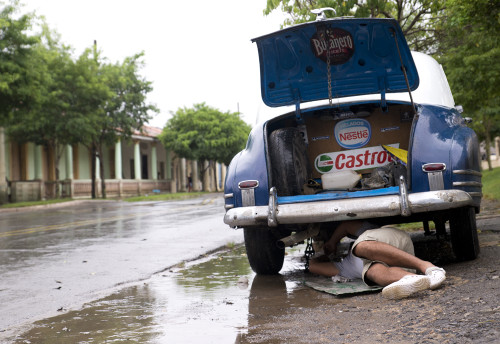
I’m a passionate environmentalist but I also love classic Detroit cars: vestiges of an era and culture not known for efficiency, even when properly maintained. Car owners in Cuba have been denied ready access to spare parts since the embargo, thus their cars are maintained with a fruitful mix of grit and ingenuity. The result is simply beautiful, and consumed most of my memory cards. Thankfully, they don’t have emission standards in Cuba, which would’ve removed these beautiful relics from the streets years ago.
The weekends and summer vacations of my childhood were spent in my parents 1982 Volkswagen Westfalia camper van, watching the roadside of the western United States whiz by my backseat window. Many of my dad’s weekends, however, were spent underneath the van, especially as the annual emissions test drew near. (And, most likely, a few weekends following the first, failed test). In Japan, if absolutely anything on your car is not performing optimally, it must be fixed or replaced before it is allowed on the street for another year.
Stand on a corner in downtown Havana and it’ll become quite clear, to your eyes and nose, that these restrictions have not penetrated Cuba’s borders. But one look at a Fairlane or Edsel and you simply won’t care.
Hitchhiking
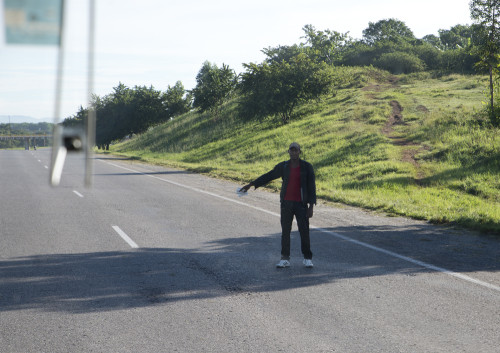
In the US, the legality of hitchhiking varies from state to state. It is, however, illegal to hitchhike on an interstate highway. While we drove down the impressively smooth Autopista Este-Oeste highway from Havana to Viñales, I was blown away by the number of people blatantly waiting for rides. Literally on the highway. Our bus driver would often have to swerve into the fast lane to avoid hitting people, who lurked in the shadows of overpasses to avoid the sun. It’s an efficient way to get places in a country that lacks transportation infrastructure and where owning a car is expensive. It just wouldn’t fly in the US, where you can’t even park on the shoulder without being pestered by highway patrol within minutes.
Gas Prices
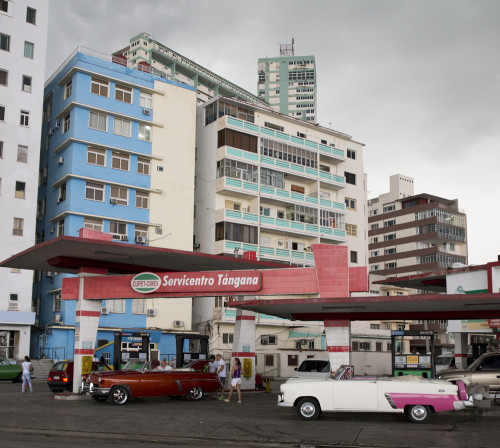
Venezuela is Cuba’s largest provider of oil, supplying 60% of the island’s demand (Cuba, in exchange, sent 30,000 doctors to Venezuela – source). Venezuela is also famous for having the cheapest gas in the world: $0.06/gallon (source). The fact that Venezuela supplies such cheap oil to Cuba almost guarantees that these Detroit relics would enjoy subsidized gas prices.
Nope. Gas is nearly $6/gallon in Cuba. If you even find a car available for sale in Cuba, and can afford the asking price (think supply/demand curve), you then have to be able afford to fill it up.
And, courtesy of restrictions put in place by both the Cuban and U.S. governments, this isn’t exactly an island of Priuses.
Glacial Internet
The internet in Cuba is tightly controlled to prevent the free exchange of ideas. But it isn’t just expensive, it’s based on infrastructure that’s decades old.
Terms like “dial-up” and “56k” don’t resonate with today’s youth. They can’t relate to the rhythmic, robotic sound of a computer dialing a god-damned phone number and, after waiting 15 seconds for a connection, which often failed, only to watch it struggle to pull down text emails so slowly that you’d watch, with great anticipation, visual bars that tracked its progress.
Remember that? That’s Internet access in Cuba. And even that isn’t readily accessible.
Journalists get 120 hours of free internet access a month. Many sell a portion of their access on the black market to help supplement their monthly salaries. I met a gentlemen who purchases 40-60 hours of internet access a month, for 3 CUC/hour* (about US$3.39). This monthly transaction was the equivalent to six months salary for the average government worker.
Thus, internet access is very much a luxury. And don’t forget it’s slow, like “frozen molasses” slow: loading Facebook takes 25 minutes on his computer and a one megabyte file – roughly half the size of a picture taken with an iPhone – takes two hours to download. In the U.S., where a frozen Facebook video is grounds to throw your $600 smartphone against a wall, this would simply not fly.
Internet is available to tourists in nicer hotels, and the situation will only improve. Just two months after our trip, President Obama announced the normalization of relations with Cuba. Within weeks, NetFlix and AirBnB announced their plans to enter the thawing market.
I used our six-day trip as an excuse to unplug; it was delightful.
Immigration Coffee Break
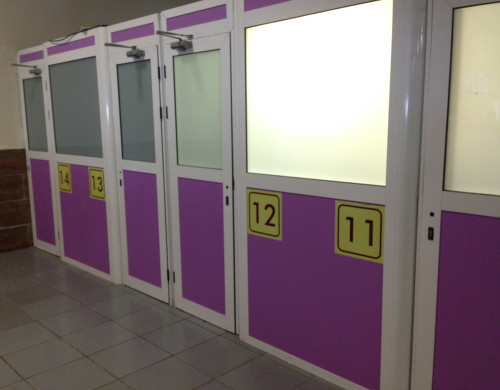
No one ever has a pleasant time going through immigrations and passport control. If you do, you have some sort of weird “I enjoy skeptical stares from strangers” fetish. I think my best experiences in immigration could be described as “frosty.” (This is especially the case returning to the U.S.). But, like removing one’s shoes in security, it just becomes a part of the adventure of travel.
I had an easy time entering Cuba. But, on our exit, our experience was a little different: the lines at passport control suddenly stopped moving. The doors closed. Officials moved briskly in front of the closed doors, purposefully avoiding eye contact with the twenty or so people still waiting in line. It took fifteen minutes for the lines to open again, as inexplicably as they’d closed. Apparently, the agents simply went on break.
If this had happened in the U.S. – where the stresses of travel reduce Americans into monsters with the self-entitlement of a toddler, the patience of a New York cabbie in rush hour, and the moral depravity of J. Dahlmer – these agents would’ve returned to a crime scene: a landscape strewn with torches, torn tropical shirts, and warring factions whose faces were smeared with the blood of their victims.
Homeless Dogs and Cats with Name-tags
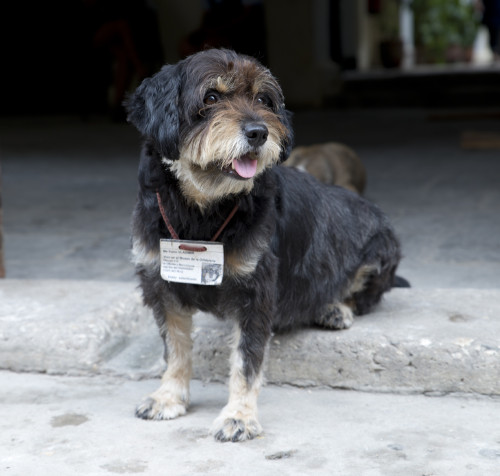
We ran across several dogs in old Havana donning name tags that advertises that they are owned and cared for, which apparently prevents them from getting swept up by animal control. We have this in the U.S., obviously, but you got to admit that it’s pretty damn cute. It almost looks like he has a handmade keycard lanyard and works at Amazon.
Beer Desert
I only saw two types of beer during our six day tour of the island, both of which were comparable to American macrobrew in look and taste (though, after a long day in the sun, any liquid under 98.6º is refreshing). If a restaurant in Seattle even attempted to open with only two beers on draught – and macrobrews at that – the establishment would be torched by an hirsute, flannel-clad cadre of lumbersexuals before the first pint was poured.
After my second mojito or Cuba Libre, however, I no longer cared.
Entering through the ass-end of the plane
I’ve flown a lot, but entering an airplane through stairs in the very back of the plane was new. (Envision a plane that crapped a staircase). It would’ve been unremarkable were it not for the fact that a line had formed … directly behind the idling engines. I wouldn’t describe either the 100+ decibel whine of a turbine engine or the accompanying exhaust as “delicate on the senses.” And I always enjoy boarding a flight already with a feeling of nausea deeply-seated in my gut.
“Convertible Cuban Pesos” (pronounced “kooks”) is one of two currencies in Cuba, created specifically for the tourism industry. The exchange rate is officially 1 CUC = US$1, but tourists endure a penalty and tax when exchanging, thus 0.87 CUC = US$1.
